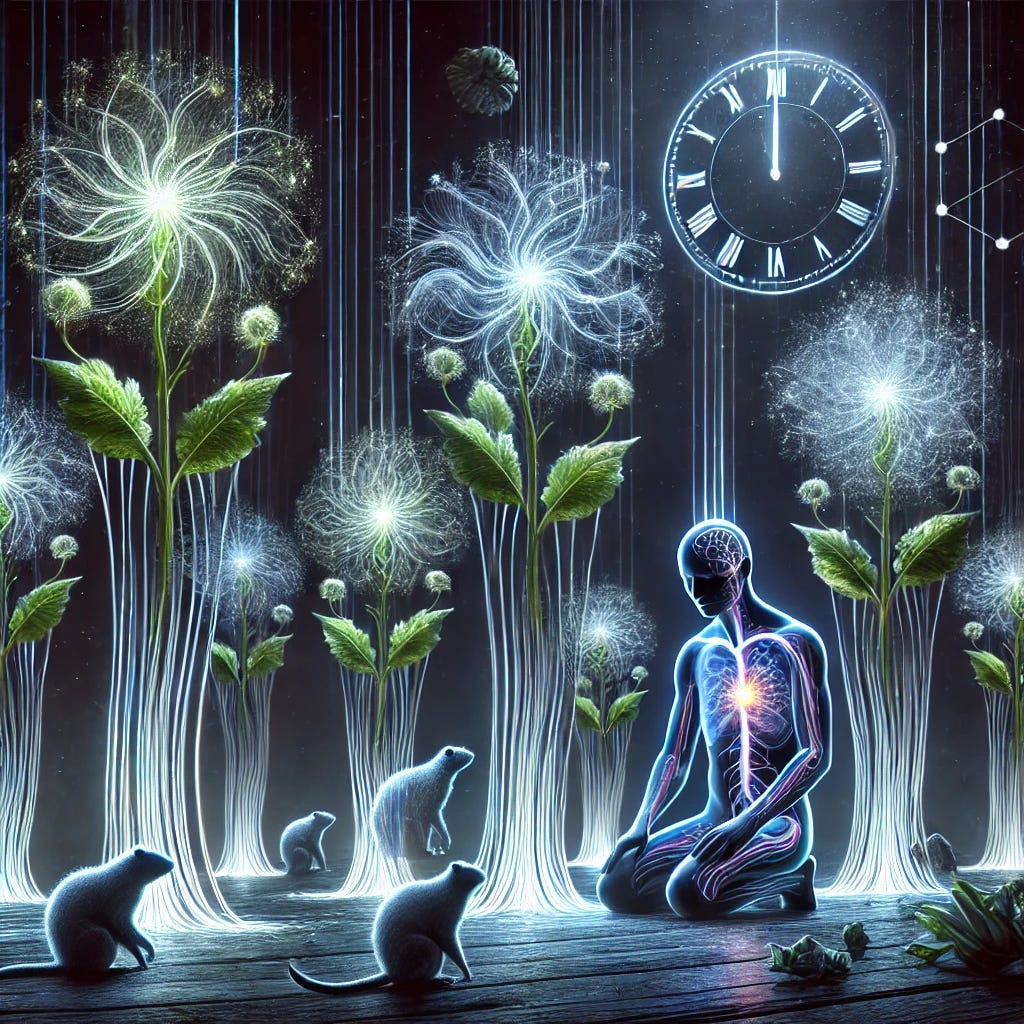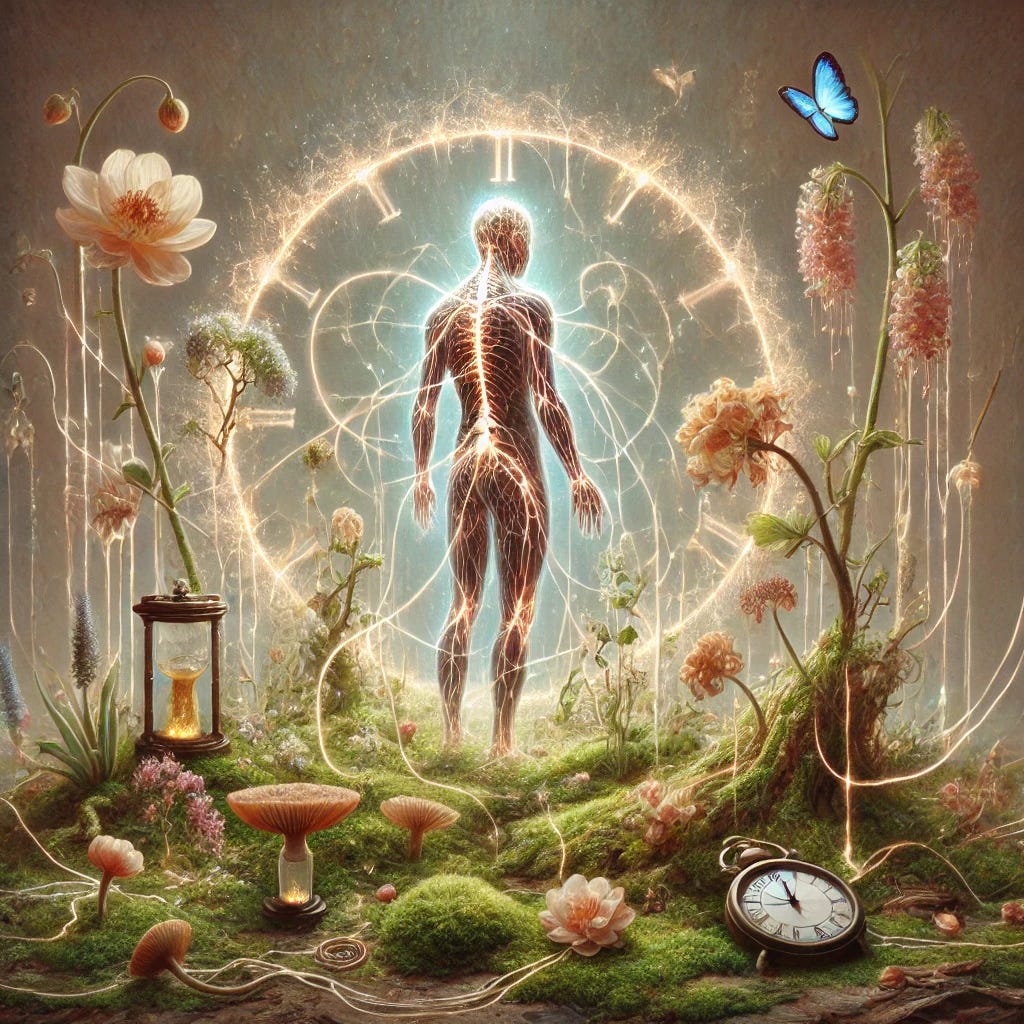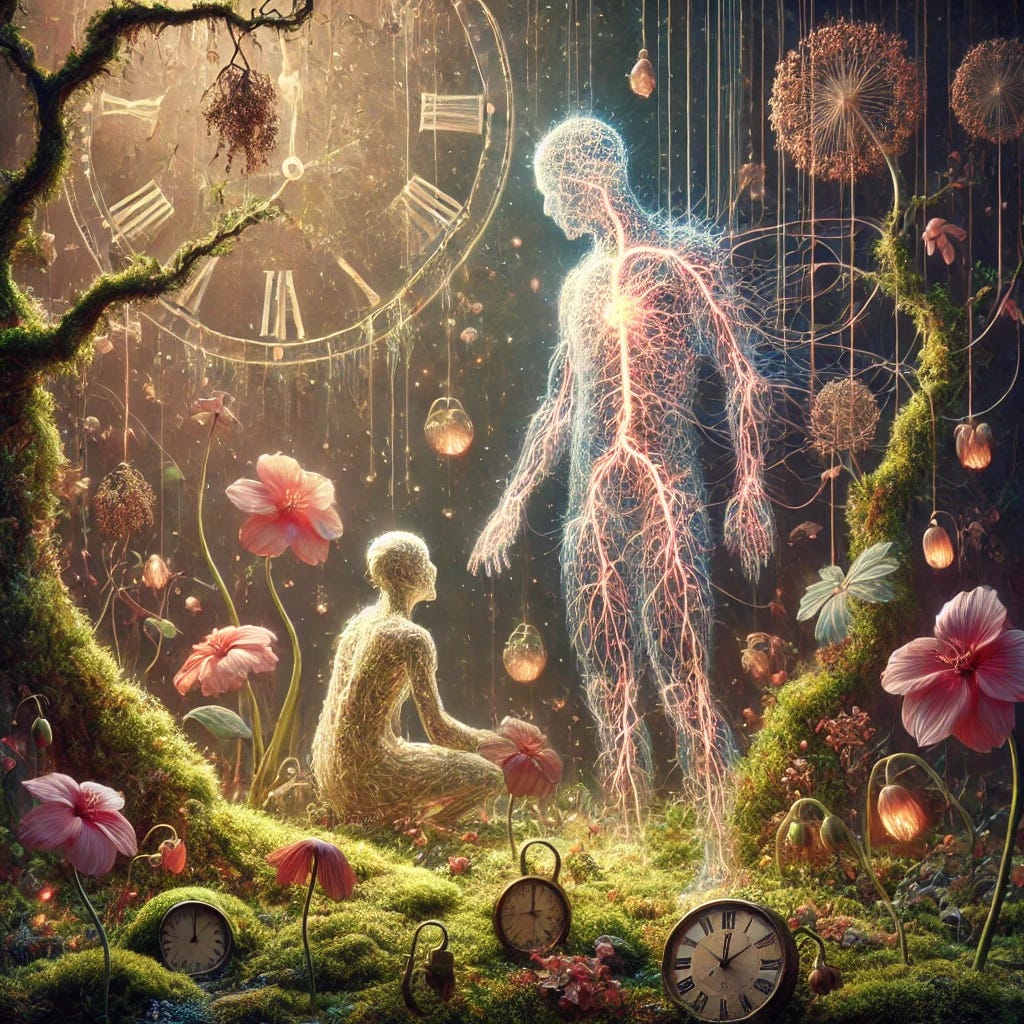Chronoecological Compression
Could Plants Manipulate Time Perception Through Ambient Biochemical Fields?
Abstract
Time perception is typically studied within the domains of neuroscience and psychology, often centering on circadian regulation and the subjective flow of temporal experience. However, emerging intersections between plant signaling, ecological interaction, and chronoception suggest a provocative possibility: that some plants may subtly influence the time perception of neighboring organisms through the emission of biochemical fields. This speculative hypothesis, which we call Chronoecological Compression (CEC), proposes that volatile organic compounds (VOCs), plant-emitted biophotons, and electrochemical fields could alter neurological or behavioral rhythms in insects, animals, or even humans, resulting in either a localized acceleration or deceleration of perceived time. The article explores foundational mechanisms, relevant experimental data, and potential evolutionary advantages of such a phenomenon.
Introduction: The Unseen Timelines of Ecology
In ecosystems, timing is everything. From the blooming of flowers that align with pollinator activity to predator-prey dynamics governed by millisecond responses, temporal coordination defines survival. Yet within this intricate dance of timing, one question remains underexplored: can some organisms, especially plants, exert active influence over the temporal perception of others?
Plants are traditionally viewed as passive players in ecological time. Their role in circadian rhythms is usually confined to photoperiodism or seasonal cycles. However, plant neurobiology has revealed unexpected agency in how plants sense, signal, and adapt to their environment (Trewavas, 2003; Calvo & Friston, 2017). Recent studies on plant signaling molecules, particularly VOCs and electrical pulses, prompt an unorthodox hypothesis: plants may not only communicate but also manipulate the sense of time in nearby organisms.
Biochemical Fields and Sensory Entrainment
Plants emit VOCs for a variety of purposes: to warn conspecifics of herbivory, to attract pollinators, or to inhibit the growth of competitors. These molecules, such as methyl jasmonate, linalool, and isoprene, are known to affect the behavior of insects, especially with regard to locomotion and feeding.
A study by Heil and Silva Bueno (2007) showed that lima bean plants can attract predatory mites by emitting VOCs in response to herbivore attack, modifying predator behavior in a time-sensitive manner. But what if the emissions went beyond simple chemical signaling and altered how quickly those predators perceived time?
In humans and animals, exposure to certain scents (like lavender or rosemary) can alter subjective time estimation (Moss et al., 2003). Neurological studies show that odors influence oscillatory activity in the brain’s temporal networks, including the suprachiasmatic nucleus and cortical theta rhythms (Herz, 2009). If plant-emitted molecules can entrain these rhythms, even subtly, then local biochemistry could compress or dilate perceived time.
Biophotons and Quantum Biological Timekeeping
Biophotons, ultraweak photon emissions from biological systems, have been detected in plant tissues and are thought to correlate with metabolic activity. While often overlooked, some researchers have posited that biophoton exchange could mediate intercellular communication (Popp et al., 2002).
The speculative layer here is whether these emissions, modulated by specific plant states (e.g., stress, bloom, root signaling), could interface with animal circadian photoreceptors or retinal ganglion cells in a nonvisual way. Theoretical work in quantum biology (Hameroff & Penrose, 2014) has suggested that biological systems may be sensitive to quantum coherence and light-phase information. Plants, therefore, might emit structured biophotons that modulate the internal clocks of nearby organisms.
Temporal Modulation as an Evolutionary Strategy
Why would a plant evolve such a capability? The utility could range from defense to reproductive optimization. If a plant could delay a predator's perceived time (i.e., slow their reaction speed), this would increase its survival chances. Conversely, speeding up a pollinator’s time perception might lead to faster foraging behavior, increasing pollination rates.
One possible example is the night-blooming jasmine (Cestrum nocturnum), which emits powerful VOCs at dusk. Bats and moths visiting the flower show accelerated foraging bursts in controlled environments with synthetic scent mimics, a phenomenon not yet linked to time perception but behaviorally suggestive.
Experimental Proposals
A preliminary experimental framework could involve placing test animals (e.g., fruit flies or small rodents) in controlled olfactory chambers infused with specific plant VOCs. Their time estimation abilities could be measured using standard interval timing tasks, such as fixed interval response schedules or temporal bisection paradigms. Neural oscillation recordings (EEG) would reveal whether olfactory exposure modulates theta or gamma coherence, which correlate with timing judgments.
Biophoton experiments might involve plant-animal cohabitation in light-isolated enclosures fitted with photomultiplier tubes to detect photon flux. If exposure to plant-emitted photons shifts circadian gene expression (e.g., Per, Cry), it would support the idea of photonic chronoentrainment.
Speculative Technological Extension: Botanical Timefield Devices
If plants can indeed generate local fields that modulate time perception through volatile biochemical and biophotonic emissions, then it opens the door to synthetic replication. A technological analog of this capacity could take the form of Botanical Timefield Devices (BTDs), engineered systems that mimic or amplify the chrono-modulatory properties of specific plant species.
These devices might consist of bioelectronic substrates embedded with programmable scent emitters, quantum dot–based biophoton emitters, and oscillatory electromagnetic circuits tuned to match plant emission spectra and frequency envelopes. Artificial intelligence systems could learn environmental feedback from human brainwave or behavioral response data and then modulate the emission profile in real-time, creating dynamic “temporal climate zones” in physical spaces.
Potential applications include time therapy chambers for neurological conditions like Parkinson’s or ADHD, where distorted time perception is a symptom. Another application involves enhanced focus environments in education or cognitive workspaces, using scent-photonic fields to slow subjective time, improving learning and task immersion. Finally, one could apply art installations that induce altered states of temporal awareness in gallery spaces through programmable botanical fields.
In an ambitious future, urban architecture might incorporate rooftop plant arrays or engineered moss walls designed to influence the tempo of human behavior in congested areas, slowing perception in transit zones to reduce stress or quickening it in economic centers to subtly encourage decision-making.
Philosophical Extension: Toward a Vegetal Chronoaesthetics
The notion that plants can modulate temporal experience invokes a deeper philosophical reimagining of what it means to be temporally situated. Time, as traditionally construed, flows in a linear, objective stream, indifferent to organic perception. But if plants can act as time-sculptors, then time becomes not just biologically interpreted, but ecologically co-constructed.
This leads to what we might term vegetal chronoaesthetics, the idea that time perception is shaped not solely by internal neural processes but also by aesthetic and ecological exposure. Forests, for example, may not only provide air and shelter, but sculpt the psychological experience of duration, rhythm, and recurrence. The ambiance of a botanical environment becomes a kind of temporal artwork, shaped by leaf volatiles, photonic flux, and rhythmic biomatter.
Such a view aligns with indigenous epistemologies, where forests and sacred groves are understood as places where time feels different. Rather than superstition, these may be ancient phenomenological observations of real bio-chronoecological effects.
In this light, the human nervous system is not a closed clock, but a permeable temporal membrane, modulated by the flora with which it co-evolved. The rhythms of moss, the pulsing of flowers, and the timing of decay may not merely symbolize time, they may create it.
Philosophical Considerations
CEC implies a radically relational view of time, not as a universal flow but as something locally sculpted by ecological actors. Time becomes not only subjective but possibly communicable, manipulable, and contextually engineered. In this sense, temporal perception joins other modalities (like taste or vision) as potentially co-evolved with plants.
This aligns with extended mind theory, where cognitive processes span across organisms and environments (Clark & Chalmers, 1998). If plants can entrain, distort, or calibrate perception, they may form part of a cognitive ecology larger than previously imagined.
References
Calvo, P., & Friston, K. (2017). Predictive processing and plant intelligence. Philosophical Transactions of the Royal Society B, 372(1725), 20160045.
Clark, A., & Chalmers, D. (1998). The extended mind. Analysis, 58(1), 7–19.
Hameroff, S., & Penrose, R. (2014). Consciousness in the universe: A review of the 'Orch OR' theory. Physics of Life Reviews, 11(1), 39–78.
Heil, M., & Silva Bueno, J. C. (2007). Within-plant signaling by volatiles leads to induction and priming of an indirect plant defense in nature. Proceedings of the National Academy of Sciences, 104(13), 5467–5472.
Herz, R. S. (2009). Aromatherapy facts and fictions: A scientific analysis of olfactory effects on mood, physiology and behavior. International Journal of Neuroscience, 119(2), 263–90.
Moss, M., Cook, J., Wesnes, K., & Duckett, P. (2003). Aromas of rosemary and lavender essential oils differentially affect cognition and mood in healthy adults. International Journal of Neuroscience, 113(1), 15–38.
Popp, F. A., et al. (2002). Biophoton emission: Experimental background and theoretical approaches. Modern Physics Letters B, 16(19), 803–826.
Trewavas, A. (2003). Aspects of plant intelligence. Annals of Botany, 92(1), 1–20.








Extremely interesting.
"In humans and animals, exposure to certain scents (like lavender or rosemary) can alter subjective time estimation (Moss et al., 2003). Neurological studies show that odors influence oscillatory activity in the brain’s temporal networks, including the suprachiasmatic nucleus and cortical theta rhythms (Herz, 2009)."
I will be interested to read these two references. Is there any indication of the extent to which such time distortion might be pushed synthetically or organically?
"Time, as traditionally construed, flows in a linear, objective stream, indifferent to organic perception. But if plants can act as time-sculptors, then time becomes not just biologically interpreted, but ecologically co-constructed."
This is very rich, but does not seem to really indicate that our conception of time as linear and one-directional needs revision: a slowing is not a reversal; it is not, either, a disjunction into two parallel experiential timelines, which it seems would be necessary to interpret any alterations in flow or direction as requiring this kind of revision to our concept of time.
"In this light, the human nervous system is not a closed clock, but a permeable temporal membrane, modulated by the flora with which it co-evolved."
This is my takeaway here, and it is fascinating. Thank you so much!
“Thanks for sharing this—it really spoke to me. It’s striking how our lives now operate under a kind of time compression, where every moment competes against the next notification or deadline. What if we intentionally decompressed our personal time? For example, committing to a weekly ‘no-screen sundown,’ or syncing more with natural rhythms—like choosing plant-based meals when the season supports them, or walking outdoors at dawn just to notice how the world changes day by day. Slowing down might seem counterproductive in a fast-paced world, but I believe it could restore our connection to self, others, and the planet. I’m curious—how would you start reclaiming a more natural rhythm in your life?”